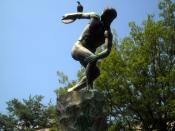Relationships of Science to People
> Science is a topic that relates to everyone in someway. In many aspects
ofliterature, science is depicted in a way that shows the great significance it
holds overpeople. While the style of writing may differ depending on the
author, you can still betaken on a journey and actually experience the
situations of others. In the writings byRichard Selzer, Roy C. Selby Jr., and
Michel Brown, the reader is successfully taken onthis journey.
> "The Discus Thrower" by Richard Selzer and "A
DelicateOperation" by Roy Selby Jr. are similar in that they are both
written from the pointof view of doctors. Selzer describes his experience of
observing an old blind man whodoes not have his legs. Selby writes about a
surgeon performing an operation to remove atumor from a woman's brain,
seemingly based on his own experience. You do not haveto be a doctor, however,
in order to use science to tell a story.
Michael Brown is anenvironmentalist
who wrote "Love Canal and the Poisoning of America." He useshis
skills of investigation to show the horrors of a city plagued by the dumping of
toxicwaste.
> All three stories are similar in the fact that they paint a picture of
the medicaldistress that the people are in. Selzer goes into detail when
describing the old blindman, even going as far as to question if the man
remembers "when his body was not arotting log" (Selzer 290). When
reading about the plight of the woman, you caneasily understand the severity of
the situation. If not operated on the woman could goblind. If she is operated
on, she still has potential to lose her vision or even die. The surgeon Selby
writes about is clearly dealing with an operation that would be thedifference
between life and death.
> It almost seems like you are a fly on the wall when reading Brown's
story of thetoxic waste dumping in the city of Niagara Falls. Small stories of
the families livingthere made it impossible not to feel for them. "The
child was born with a heartbeat irregularly and had a hole in it, bone
blockages of the nose, partial deafness,deformed ear exteriors, and a cleft
plate" (Brown 300). That description shows justone of the scientific
tragedies of the city.The greatest similarity between all threepieces is that
all three authors are sympathetic to the situations they write about.
Manytimes doctors do not get attached to their patients, as it would provide
greatconsequences to their work ethic. It would be impossible to grieve for
the immense numberof patients they attempt to treat daily. Yet, in these
pieces both doctors do seem togrow attached. Though everyone has a strong
dislike for the old man in Selzer'spiece, the doctor respects him.
Selzer cares for him and watches over him when he doesnot have to. Dr.
Selby's surgeon too cares for his patient, which is seen in hisactions
after the surgery. "Though exhausted, he could not fall asleep until
aftertwo in the morning" (Selby 297). It took a call from intensive care
to calm hisnerves. Finally, Brown too shows sympathy, but it is as a narrator
for the city. Heexploits the shame that the company responsible for the waste
should have, whileportraying the citizens as
> unfortunate victims.
> While the pieces have similarities, it is important to see that they do
differ from eachother. The two hospital stories are written in the present
tense, while Brown's iswritten in the past. This style fits the mood
each story portrays. With the hospitalstories being written in the first
person, it feels like you are a part of the story inthe way that you are the
doctor's assistant. It has the feel of a live action show. The piece on
the city is an account of what the toxic waste caused. This provides as
thebest writing method for this situation, as one can look back and see the
destruction andthe pain that burdened a city.
> Another slight difference is the amount of people in each story that went
throughtribulations. The writings of both Selzer and Selby focus mostly on the
doctor/patientrelationship. On the other hand, Brown actually described
separate stories of differentfamilies in the town. One described a situation
where a family's basement containeda toxicity level of "thousands
of times the acceptable limit fortwenty-four-hour-breathing" (Brown
305). While not a major difference, this didprovide for the best presentation
to actually feel what the characters were goingthrough.Finally, the greatest
difference between the three pieces is the writing styleeach author uses.
Selzer uses a style that is void of scientific references. He simplytells a
story about a sick old man whose only enjoyment in life is an every day ritual
ofthrowing his plate of eggs at a wall. Everything is clear as it is easy to
see therespect and sympathy the doctor has for the man. Selby's piece
possesses the mostscientific language. The description of the operation
provides for some gruesome detail. "The incised piece of skull was pried
loose and held out of the way by a largesponge" (Selby 296). Still, even
with the use of such scientific terms as ahypothalamus or a dura, the story
remains quite interesting due to the detail involved. Brown provides for some
scientific talk. He goes into detail about the specific names ofthe chemicals
found in the city. However, it is written in a way where this can beoverlooked
and one can relate to the tragic human experience that the
> city is involved in.
> Everyone relates to the subject of science at one time or another. Selzer,
Selby, andBrown are no exception as they experienced science in their own way.
Whether it is from amedical operation or an environmental problem, everyone has
been or will be affected atsome point in time. Therefore, it is important to
learn about and attain as muchinformation about the topic, as one possibly can.
>
>
>
>
>
>
>
>
>
>
>
>
>
>
>
>
> Works Cited
> Brown, Michael. "Love Canal and the Poisoning of America." Comley,
> 299-313.
> Comley, Nancy, ed. Fields of Reading. Boston:
> Bedford/St. Martin's, 2001.
> Selby Jr., Roy C. "A Delicate Operation." Comley,
> 295-298.
> Selzer, Richard. "The Discus Thrower." Comley,
> 289-292.
>


